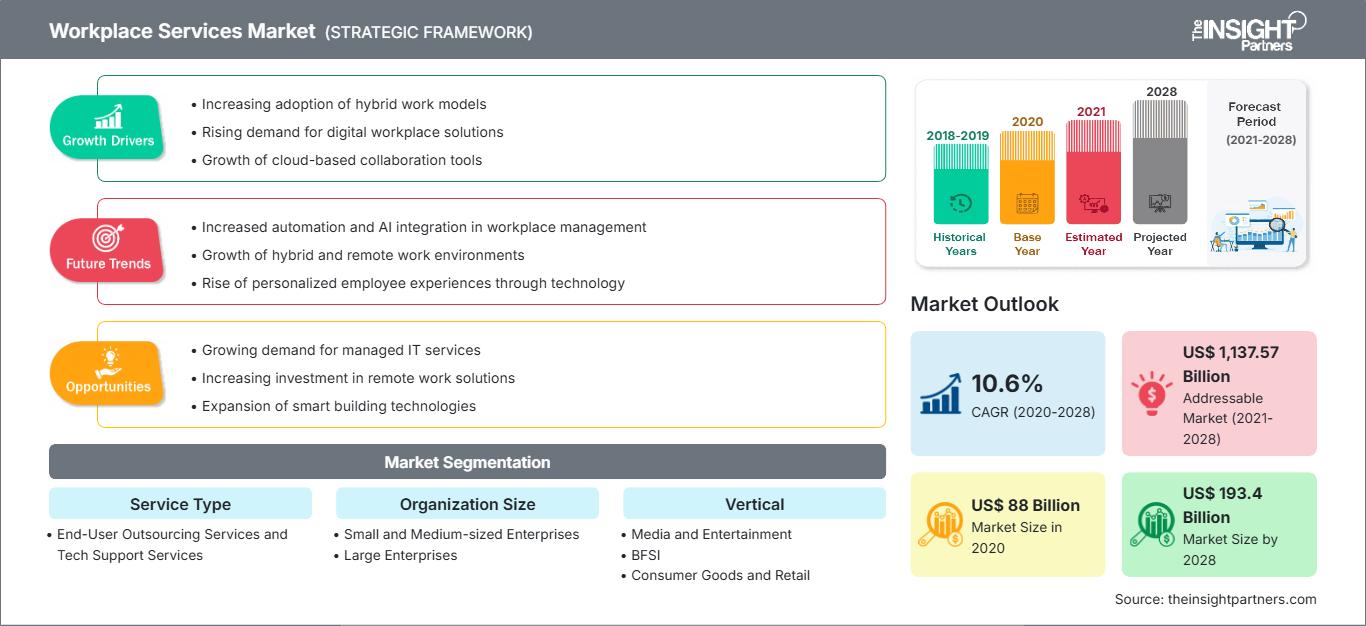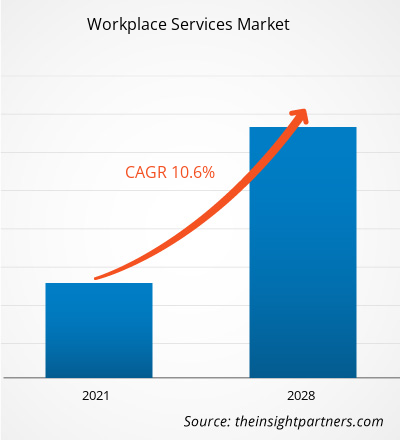Il mercato dei servizi per il posto di lavoro è stato valutato a 88,0 miliardi di dollari nel 2020 e si prevede che raggiungerà i 193,4 miliardi di dollari entro il 2028; si prevede una crescita a un CAGR del 10,6% dal 2021 al 2028.
La tecnologia offre numerosi vantaggi per le aziende. Una crescita esponenziale di applicazioni, dispositivi e reti sta creando un impatto positivo sulla cultura aziendale. Ambienti di lavoro più sicuri, un ambiente di lavoro ibrido, una maggiore sicurezza informatica e una forza lavoro distribuita a livello globale sono alcuni degli aspetti che contribuiscono al concetto di ambiente di lavoro moderno, influenzando di conseguenza la crescita dei servizi per il posto di lavoro. Pertanto, l'infrastruttura IT consolidata e le piccole, medie e grandi imprese in tutte le regioni richiedono servizi per il posto di lavoro. Si prevede che le aziende di tutte le dimensioni investiranno in tecnologie innovative e all'avanguardia per gestire efficacemente la propria attività. Le aziende di tutto il mondo utilizzano i servizi per il posto di lavoro per potenziare le proprie attività e ottimizzare gli sforzi aziendali, garantendo i requisiti di investimento più bassi possibili in vari processi.
Personalizza questo rapporto in base alle tue esigenze
Potrai personalizzare gratuitamente qualsiasi rapporto, comprese parti di questo rapporto, o analisi a livello di paese, pacchetto dati Excel, oltre a usufruire di grandi offerte e sconti per start-up e università
Mercato dei servizi sul posto di lavoro: Approfondimenti strategici

-
Ottieni le principali tendenze chiave del mercato di questo rapporto.Questo campione GRATUITO includerà l'analisi dei dati, che vanno dalle tendenze di mercato alle stime e alle previsioni.
La pandemia di COVID-19 ha scosso diversi settori. L'enorme crescita della diffusione del virus ha spinto i governi di tutto il mondo a imporre severe restrizioni alla circolazione di veicoli e persone. A causa di divieti di viaggio, lockdown di massa e chiusure aziendali, la pandemia sta influenzando negativamente le economie e innumerevoli settori in diversi paesi. I fornitori del mercato dei servizi per il posto di lavoro hanno continuato a operare da remoto per offrire i migliori servizi ai propri utenti finali. Anche durante la pandemia, diversi operatori del mercato hanno continuato a essere ben posizionati per supportare i propri utenti finali durante la crisi. La pandemia di COVID-19 ha spinto le aziende a potenziare le proprie trasformazioni digitali, con conseguente eliminazione delle tradizionali barriere al progresso. Le aziende continuano ad aiutare i propri utenti finali coinvolgendoli virtualmente, modernizzando e migrando le applicazioni sul cloud, consentendo la gestione di una forza lavoro da remoto e concentrandosi sulla sicurezza informatica e sulla resilienza IT.
Approfondimenti sul mercato dei servizi per il posto di lavoro: crescente importanza della mobilità aziendale
La mobilità aziendale è un termine ampio che include la virtualizzazione mobile, la gestione dei dispositivi mobili e la virtualizzazione mobile, che promuovono la produttività, migliorano i servizi e migliorano l'esperienza utente. Il settore della mobilità aziendale si è sviluppato enormemente da quando le aziende hanno cercato servizi in grado di gestire tutte le funzionalità della sicurezza mobile, dai dispositivi e software alla protezione dei dati. Oggi, la domanda di mobilità aziendale tra i dipendenti è al culmine, soprattutto a causa dell'epidemia di COVID-19, che sta rendendo sempre più diffuso il concetto di lavoro da remoto. La crescente adozione della mobilità aziendale consente alle aziende di controllare, aggiornare e persino cancellare i dati dai dispositivi a distanza. La mobilità aziendale consente ai dipendenti di accedere in modo sicuro ai dati aziendali sensibili senza dover installare applicazioni/software sui propri dispositivi. Pertanto, tutti questi vantaggi stanno stimolando la domanda di servizi per il posto di lavoro in tutti i settori verticali in tutto il mondo.
Approfondimenti di mercato basati sulla tipologia di servizio
In base alla tipologia di servizio, il segmento dei servizi di outsourcing per l'utente finale ha dominato il mercato. I servizi di outsourcing per l'utente finale comprendono servizi di gestione di rete, servizi di supporto remoto, reporting e documentazione standard e ad hoc, servizi di desktop virtuale ospitato, servizi software, mobilità e servizi di sicurezza.
Approfondimenti di mercato basati sulle dimensioni dell'organizzazione
In base alle dimensioni dell'organizzazione, il segmento delle grandi imprese ha dominato il mercato. Le grandi imprese di tutto il mondo si concentrano sull'ottimizzazione dei costi, oltre che sull'aumento della produttività complessiva. La crescente necessità di una piattaforma integrata per l'enorme quantità di dati provenienti da diversi settori e per prendere decisioni critiche relative ad aspetti quali strategia, marketing e gestione dei team, sta stimolando la domanda di servizi per il posto di lavoro tra le grandi imprese.
Approfondimenti di mercato basati sui settori verticali
In base al settore verticale, il segmento delle telecomunicazioni – Il segmento IT e ITES continua a detenere una quota significativa del mercato. I settori in crescita delle telecomunicazioni, dell'IT e dell'ITES richiedono servizi per il posto di lavoro altamente qualificati per adottare un approccio end-to-end nei processi di flusso di lavoro attraverso mobilità, collaborazione e supporto agli utenti, riducendo al contempo i costi operativi IT. I servizi soddisfano la moderna esigenza di luoghi di lavoro ottimizzati digitalmente in questo settore.
Gli operatori che operano nel mercato dei servizi per il posto di lavoro si concentrano su strategie, come partnership, fusioni, acquisizioni e iniziative di mercato, per mantenere le proprie posizioni sul mercato. Di seguito sono elencati alcuni sviluppi dei principali attori:
A febbraio 2021, Unisys Corporation ha annunciato una partnership con Lenovo. In base a questa partnership, Unisys Corporation supporterà le soluzioni Internet of Think (IoT) di Lenovo con i Digital Workplace Services di Unisys Corporation.
A giugno 2020, Wipro ha annunciato una partnership con Citrix e Microsoft. Grazie a questa partnership, Wipro sfrutterà i servizi di hosting offerti da Citrix e Microsoft per un'implementazione rapida e sicura di spazi di lavoro digitali affidabili (incluse suite applicative).
A dicembre 2020, DXC Technology ha annunciato la sua partnership con Microsoft. Grazie a questa partnership, DXC Technology sfrutterà la suite di servizi Microsoft, come Dynamics 365 e Power Platform, e Microsoft 365 e Teams, per migliorare e potenziare i Modern Workplace Services e la soluzione di DXC Technology.
Mercato dei servizi sul posto di lavoro
Le tendenze regionali e i fattori che influenzano il mercato dei servizi per il posto di lavoro durante il periodo di previsione sono stati ampiamente spiegati dagli analisti di The Insight Partners. Questa sezione analizza anche i segmenti e la geografia del mercato dei servizi per il posto di lavoro in Nord America, Europa, Asia-Pacifico, Medio Oriente e Africa, America Meridionale e Centrale.
Ambito del rapporto sul mercato dei servizi sul posto di lavoro
| Attributo del rapporto | Dettagli |
|---|---|
| Dimensioni del mercato in 2020 | US$ 88 Billion |
| Dimensioni del mercato per 2028 | US$ 193.4 Billion |
| CAGR globale (2020 - 2028) | 10.6% |
| Dati storici | 2018-2019 |
| Periodo di previsione | 2021-2028 |
| Segmenti coperti |
By Tipo di servizio
|
| Regioni e paesi coperti |
Nord America
|
| Leader di mercato e profili aziendali chiave |
|
Densità degli operatori del mercato dei servizi sul posto di lavoro: comprendere il suo impatto sulle dinamiche aziendali
Il mercato dei servizi per l'ambiente di lavoro è in rapida crescita, trainato dalla crescente domanda degli utenti finali, dovuta a fattori quali l'evoluzione delle preferenze dei consumatori, i progressi tecnologici e una maggiore consapevolezza dei vantaggi dei prodotti. Con l'aumento della domanda, le aziende stanno ampliando la propria offerta, innovando per soddisfare le esigenze dei consumatori e sfruttando le tendenze emergenti, alimentando ulteriormente la crescita del mercato.

- Ottieni il Mercato dei servizi sul posto di lavoro Panoramica dei principali attori chiave
- Servizi di outsourcing per l'utente finale
- Servizi di supporto tecnico
Per dimensione dell'organizzazione
- PMI
- Grandi imprese
Per settore verticale
- Telecomunicazioni – IT e ITES
- BFSI
- Manifattura
- Beni di consumo e vendita al dettaglio
- Sanità e scienze della vita
- Governo e settore pubblico
- Energia e servizi pubblici
- Media e intrattenimento
- Istruzione
- Altro
Per geografia
- Nord America
- Stati Uniti
- Canada
- Messico
- Europa
- Francia
- Germania
- Italia
- Regno Unito
- Russia
- Resto d'Europa
- Asia Pacifico (APAC)
- Cina
- India
- Sud Corea
- Giappone
- Australia
- Resto dell'APAC
- Medio Oriente e Asia Africa (MEA)
- Sudafrica
- Arabia Saudita
- Emirati Arabi Uniti
- Resto del MEA
- Sud America (SAM)
- Brasile
- Argentina
- Resto del SAM
Profili aziendali
- DXC Tecnologia
- Wipro
- IBM Corporation
- HCL Technologies
- TCS
- NTT Data
- CompuCom Systems Inc.
- ATOS
- UNISYS
- Fujitsu Ltd.
- Cognizant
- Accenture PLC
- Analisi storica (2 anni), anno base, previsione (7 anni) con CAGR
- Analisi PEST e SWOT
- Valore/volume delle dimensioni del mercato - Globale, Regionale, Nazionale
- Industria e panorama competitivo
- Set di dati Excel
Report recenti
Testimonianze
Motivo dell'acquisto
- Processo decisionale informato
- Comprensione delle dinamiche di mercato
- Analisi competitiva
- Analisi dei clienti
- Previsioni di mercato
- Mitigazione del rischio
- Pianificazione strategica
- Giustificazione degli investimenti
- Identificazione dei mercati emergenti
- Miglioramento delle strategie di marketing
- Aumento dell'efficienza operativa
- Allineamento alle tendenze normative






















 Ottieni un campione gratuito per - Mercato dei servizi sul posto di lavoro
Ottieni un campione gratuito per - Mercato dei servizi sul posto di lavoro